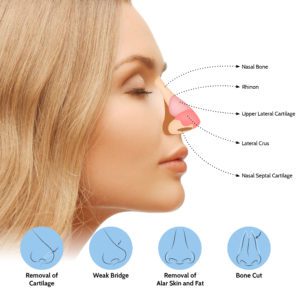 When you hear the words “nasal reconstruction,” you may think it’s the same as a nose job, but it’s not. Nasal reconstruction is a delicate, complicated procedure that can fix serious medical issues.
When you hear the words “nasal reconstruction,” you may think it’s the same as a nose job, but it’s not. Nasal reconstruction is a delicate, complicated procedure that can fix serious medical issues.
Keep reading to learn how it’s different from rhinoplasty and what problems it can fix. By the end, you will have a better understanding and appreciation for this type of nasal surgery.
Is Nasal Reconstruction Different From Rhinoplasty?
Rhinoplasty focuses on reshaping the bone and cartilage from inside the nose for improved function and appearance.
Nasal reconstruction moves skin and tissue while preserving the nasal lining. Whether it involves a simple suturing or the more complex skin graft procedure, nasal reconstruction is crucial to repairing damage and improving the physical appearance.
Problems That Nasal Reconstruction Can Fix
Here are four major issues that nasal reconstruction can resolve.
1. Birth Defect
Congenital defects such as a cleft lip can cause nasal deformities and impair the ability to breathe.
Nasal reconstruction is also necessary after the removal of nasal dermoid cysts.
2. Trauma
Blunt force trauma from sports or accidents can crush the nose and nasal passages. Nasal reconstruction restores lost cartilage and skin, rebuilding the nose. Lacerations and wounds are closed up, and the nasal bridge can be reshaped.
3. Tumor Removal
A common reason for nasal reconstruction is to cover holes left behind from Mohs surgery. When skin cancer is removed from the nose, it usually leaves some kind of defect that can be fixed with nasal reconstruction.
4. Aesthetics
Even though aesthetics isn’t the sole focus of nasal reconstruction, it is a benefit. Many people suffer from deformities and injuries that affect their quality of life. Nasal surgery can repair the damage and give them their lives back.
Conclusion
Although similar in outcome, nasal reconstruction is a different procedure than rhinoplasty. It replaces lost tissue and skin, as opposed to reshaping bone and cartilage. Even though it does have aesthetic benefits, it is usually used for medical conditions such as congenital defects, trauma, and tumor removal.
Because the nose is a prominent feature made up of several different types of tissue, great care is taken to preserve its appearance and function.
You can find out more details about nasal reconstruction here.




